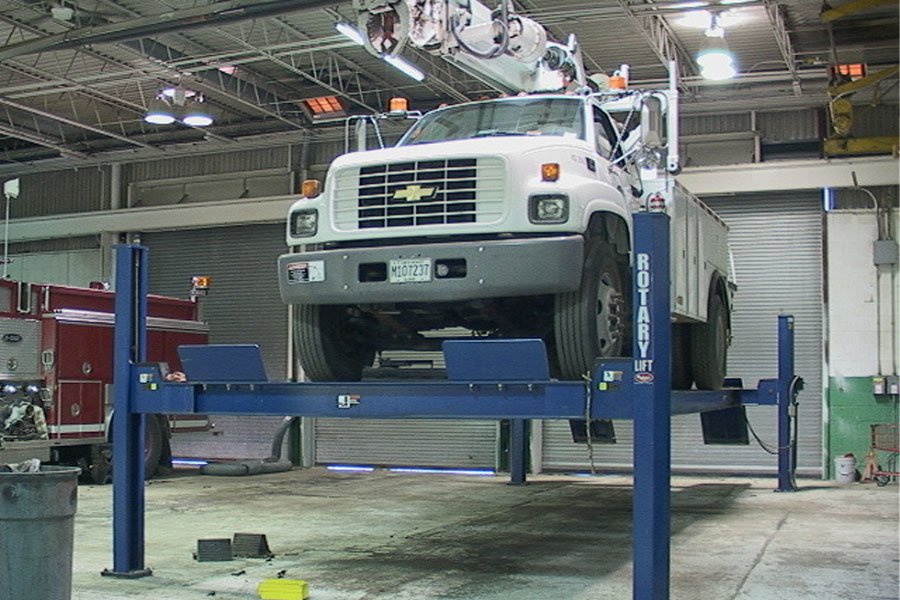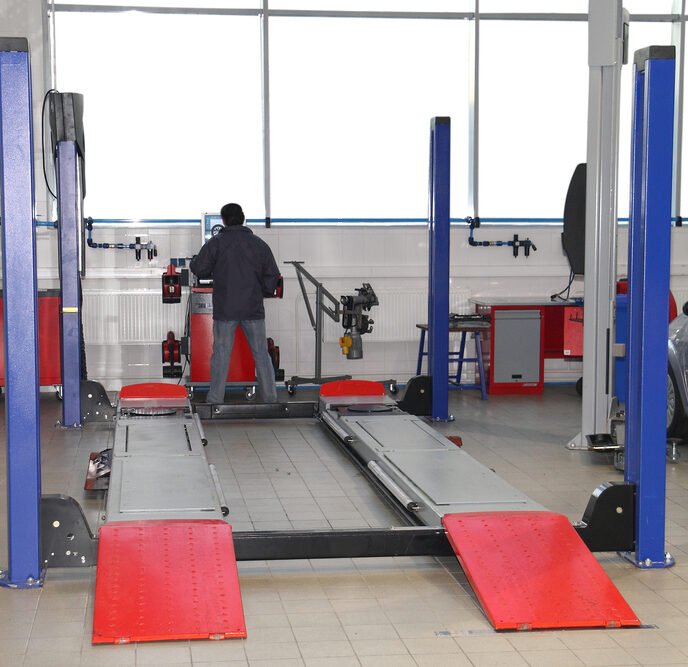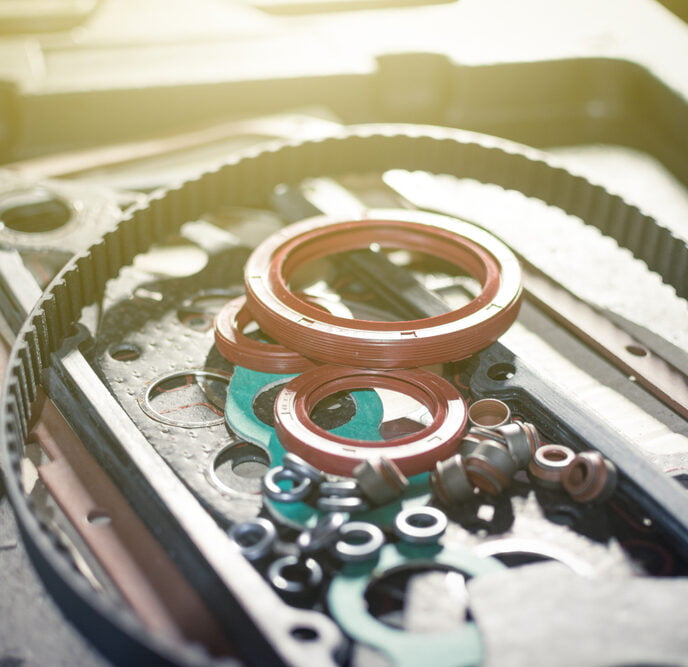Types of Car Lifts: The Complete Guide

Numerous types of car lifts coexist with a common purpose: hoisting cars. While floor jacks raise a portion of a vehicle for small repairs, car lifts raise the entire vehicle into the air for a plethora of repairs, from simple fixes to challenging projects.
Despite a singular purpose, individual lifts feature unique lifting mechanisms, bringing strength to various applications. In the content below, we explore the ins-and-outs of a wide variety of car lift types, guiding automotive shops and car enthusiasts into an informed purchasing decision for their specific function.
What are the Three Main Types of Lifts?
While examining different types of auto lifts, load capacity, lift height, and lift speed must be kept in consideration.
- Load capacity is the maximum weight a lift is capable of withstanding. Of course, load capacity differs depending on the strength of the lift, including size and number of columns or cylinders.
- Lift height is the maximum height a lift can hoist a vehicle. Height is important to consider if undercar repair will be completed. For example, a lift with a maximum height of four feet should be utilized for wheel or body work, not underbody maintenance.
- Lift speed is the amount of time needed to completely raise or lower the lift. Slower lift times are acceptable for a home garage when maintenance, repair, or body work are a hobby. Quick lift speed is exceptionally important for high volume repair shops, but lift speed and descent is also regulated for safety in high volume shops.
Frame Engaging Lifts
Excellent for use in home garages, low-rise frame engaging lifts – often scissor or parallelogram style – are the most basic model available. These lifts often have a load capacity of under 3 tons.
Electric-hydraulic or compressed air often drive frame engaging lift movement. It is important to note that frame engaging lifts do not provide access to the entire underside of the vehicle. Therefore, low-rise frame engaging lifts are most often employed for wheel work or body projects.
Two-Post Surface Mounted Lifts
Two-post surface mounted lifts are one of the most common types, often utilized in “drive-through” maintenance shops – drive in, fix the car, drive out. Consisting of two columns, these lifts are named for their design. Most mechanic shops will own two-post surface mounted lifts, because surface mounted lifts generally allow for full access to the underside of the vehicle. Full reach under the car makes repairs of any kind easy to access, especially exhaust or fuel system work.
Two-post lifts must be bolted to the floor, eliminating easy mobility. If the lift will remain put, this will not be an issue. These lifts are built symmetrically or asymmetrically.
Symmetrical Lifts
Once the vehicle is driven onto the lift, minimal space remains between the vehicle doors and lift columns. Mechanics must stay alert to protect the doors from denting if opened during repair.
Asymmetrical Lifts
These lifts are less likely to cause damage. The probability of damaging vehicle doors is les likely, because posts are rotated at a 30-degree angle. A vehicle can be driven a third of the way onto the lift while remaining evenly balanced, somewhat reducing the possibility of denting the doors.
*As an additional safety measure, invest in DoorJammer car door protection pads for your vehicle lifts.
Benefits of the two-post lift include:
- Cost: This lift is affordable for home enthusiasts and mechanic shops, often half as expensive as the four-post lifts.
- Size: Two-posts lifts are small, allowing for accessibility in tight spaces. This is ideal for personal garages and mechanic shops requiring multiple lifts.
- Ease-of-Use:
Because
two-post lifts have four arms they accommodate a wide range of varying lift
points.
A final consideration is load capacity. The majority of two-post lifts have a maximum load capacity below 20,000 lbs. Thus, this lift model is ideal for light trucks, vans and cars.
Four-Post Lifts
The four-post lift is commonly considered the most popular and versatile car lifts that a shop can utilize.
Due to extra support, four-posts lifts are extremely sturdy, with greater load capacity than their two-post counterparts. Four-post runway lifts are wheel-engaging, allowing vehicles to drive directly onto the lift. The lift can adjust to the work being done. For example, the car’s wheels rest on the lift for undercarriage work but with the use of rolling jacks can be removed for wheel and brake work.
With a four-post lift, you can reach heights of up to 14 feet to work on a vehicle. Their load capacity makes four-post lifts a common solution in the automotive repair industry. Certain four-post lifts don’t require anchorage to the floor, allowing them to be moved with ease when needed. Though common in a professional setting, four-post lifts can also be found in the hands of homeowners and automotive enthusiasts – largely due to their mobility and use as a way to store more cars in small space one right over the other.
Four-post lifts can double as storage, allowing for two cars stacked in the same location.
Drive-On Parallelogram Lifts
The parallelogram lift resembles both the four-post lift and scissor lift. In functionality, the parallelogram lift is drive-on, like the four-post. Aesthetically, it resembles a scissor lift with accordion-like hoisting mechanisms beneath runways. The parallelogram differentiates itself in mobility; it moves slightly forward or backward while in motion.
In-Ground Lifts
In-ground lifts have been a widespread component of automotive shops for years, an industry standard. Their key characteristic is in the name; these lifts descend into the floor when not in use. In-ground lifts are also popular for flexibility of design. They can either be frame or wheel engaging.
In-ground auto lifts are often equal in cost to other lifts and do require more installation steps and time. However, their unique functionality, low cost of ownership and durability have proved extraordinary in automotive repair shops and home garages for decades.
Power Post in-ground lifting systems have proven more reliable and economical than any other. Power Post lifts are durable; many shops utilize lifts installed over 50 years prior, operating just as excellently as the day they were installed.
Power Post lifts are low-pressure hydraulic lifting systems from SVI International, Inc. These lifts are not illegal, banned, or even under consideration for regulation. The EPA has permanently exempted in-ground low-pressure lifts from regulation.
In-ground lifts generally fit into three categories: front and rear lifts, side by side lift, and single post lifts. Below, we explore a small sample of each kind with significant differences.
In-Ground Front and Rear Car Lifts
Each front and rear car lift listed below has similar stats, excluding lifting capacity. Our goal is to provide a starting place for identifying the best lift for your situation.
- 2P-102:
- Lifting capacity: 11,000 lbs., evenly distributed on front and rear columns
- Single moveable front and single stationary rear
- Axle engaging
- Adjustable front cylinder
- Air/hydraulic oil operated
- Post diameters: 7 ½ inches front and rear
- Lift height: 69 inches front and 73 inches rear, based on standard adapters
- Multiple lip seal design for increased performance
- 2P-103:
- Lifting capacity: 16,000 lbs., evenly distributed on front and rear columns
- 2P-202:
- Lifting capacity: 11,000 lbs., evenly distributed on both columns
- 2P-203:
- Lifting capacity: 16,000 lbs., evenly distributed on both columns
In-Ground Side by Side Car Lifts:
- FSDT-28BS
- Lifting capacity: 12,000 lbs., evenly distributed on front and rear columns
- Operation: Full-hydraulic
- Lift height: 72 inches from the floor to the top of the adapter pad without extension
- Plunger centers: 57 ½ inches; mechanical, heavy-duty racks equalize plunger movement
- Cylinders: 8 ½ inches in diameter
- Solid steel bolster-style and low-profile swing arms
- 360-degree adapters nesting style, swivel adjustable on sliding sleeves
- Automatic locking: a spring-loaded latch automatically engage into notches as the lift is raised. Release lock while lowering; the lock will automatically reset for the next job.
In-Ground Single Post Car Lifts:
- FS-10AS
- Environmentally friendly
- Safe to operate
- Handles most domestic and imported models
- 4-position adapters provide undercar accessibility
- 4-inch road clearance
- Ideal for any shop or home garage
- Excellent for front-end and suspension work
- Lift capacity: 8,000 lbs.
- Operation: Semi hydraulic or full hydraulic
- Lift height: 72 inches
- SC-363
- Perfect for lifting sports cars, specifically Porsche 911 models
- Associated with wealthy enthusiasts, racing and high-performance markets
- Unequivocally safer than any old-fashioned lift
- Lifts at specifically intended pick-up points
- Optional 360-degree rotation keeps mechanics between the work and workbench
- Low maintenance
- Simple design
Explore Different Types of Lifts with SVI International, Inc.
SVI International, Inc is the industry leader in automotive lifts and lift repair parts, providing over 40,000 repair parts for a plethora of lifts and brand-new auto lifts of extraordinary quality. SVI is dedicated to providing innovative solutions to solve industry challenges. If a required part has been previously discontinued by its original maker, our team of fully degreed mechanical engineers design an alternative solution that others won’t be bothered to help with.
Our three “Ready-Ship” warehouses ensure that our solutions are delivered quickly, without affecting a business’ bottom line. To inquire about our products or request a quote, contact our team today at (800) 321-8173 or via our online contact form.


